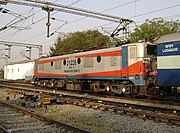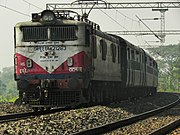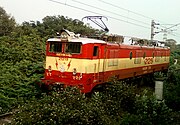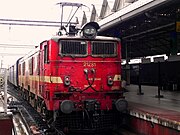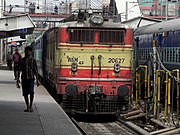IR class WAM-4
| IR class WAM-4 | |
|---|---|
|
WAM-4 No. 20652 on the Arakkonam depot of the Southern Railway with an express train
|
|
| Numbering: | 20400-20699 21101-21138 1 21200-21399 1 This series was later WAG-5B redrawn |
| Number: | 500 |
| Manufacturer: | CLW |
| Year of construction (s): | 1970-1983 |
| Retirement: | 2005-2020 |
| Axis formula : | Co'Co ' |
| Gauge : | 1676 mm |
| Length over coupling: | 19,974 mm |
| Height: | 4,162 mm |
| Width: | 3,055 mm |
| Bogie axle base: | 3,810 mm |
| Service mass: | 112.8 t |
| Wheel set mass : | 18.8 t |
| Top speed: | 120 km / h |
| Hourly output : | 3,850 hp (2,830 kW) |
| Continuous output : | 3,640 hp (2,680 kW) |
| Starting tractive effort: | 30 t (295 kN) |
| Wheel diameter: | 1,092 mm |
| Power system : | 25 kV 50 Hz ~ |
| Power transmission: | 2 single arm pantographs type Faiveley AM-12 |
| Number of traction motors: | 6 × Alstom / CLW TAO 659A1 (hour: 798 hp (587 kW) at 750 V, 840 A to 1070 min -1 Weight:. T 2.8) |
| Drive: | Pawbearing drive |
| Transmission ratio: | originally 1: 4.13, later also 1: 2.76 |
| Locomotive brake: |
Resistance brake , direct brake handbrake |
| Train brake: | Vacuum brake |
The WAM-4 is an electric locomotives of Indian Railways for operation with 25 kV alternating current with a frequency of 50 Hz, the 1970 Chittaranjan Locomotive Works was developed (CLW). The designation of the series consists of W for wide ' Breitspur ' , A for alternating current 'Alternating current' and mixed ' Universal locomotive for goods and passenger traffic ' . A 4 follows the hyphen to mark the 4th generation of WAM locomotives. Between 1978 and 1983 a total of 500 WAM-4s were built by the CLW , which made them the most popular series of Indian electric locomotives right up to their successor, the WAG-5 . The WAM-4 is one of Indian Railways' most successful locomotives, having been in service for 50 years. The locomotive was the basis for several other series such as the WCAM-1 , the WAG-5A , the WCG-2 and some WAP models. With the advent of three-phase locomotives of the WAP-5 and WAP-7 series , the WAM-4 were only used to transport subordinate passenger trains before they were decommissioned in 2005.
history
In the early 1970s, the goal was set to develop a locomotive in India that would remedy the shortcomings of the earlier WAM-1 and WAM-2/3 series . The WAM-1 series did not prove itself, as some of its then advanced design features were unsuitable for Indian conditions. At the same time, large numbers had to be produced in order to be able to stop steam operation by 1990. In these years, almost 1000 km of routes were electrified every year , so that there was a great need for electric locomotives. The WAM-4 was the first electric locomotive developed entirely in India.
The engineers of the Research Design and Standards Organization (RDSO), the research and development department of Indian Railways, and the CLW decided on a locomotive with the following key points:
- Asymmetrical three-axle ALCo bogies, as used in the WDM-2 , instead of the two-axle bogies of the earlier WAM series. This should give the locomotive better traction compared to the previous series
- Rectifier with silicon - Diodes
- Control of the traction motors by regrouping and using the field weakening
- Auxiliary drive components mainly from Indian manufacturers: air compressors from Westinghouse and Kirloskar, fans from SF India and vacuum pumps from the English manufacturer Northey
- Compressed air brakes and resistance brakes for the locomotive combined with suction air brakes for the train
- Multiple traction of up to four units.
Production of the WAM-4 began in 1970 with the number 20400. 500 WAM-4s were built in 13 years, with number 21399 with the name Anant being the last. The successful series was adapted to Indian conditions, very robust and easy to maintain.
technology
The electricity was fed from the pantographs to the transformer via a main compressed air switch. This consisted of an autotransformer , the output voltage of which could be changed with a high-voltage tap selector, and a galvanically isolated transformer with a fixed transformation ratio, both of which were mounted on the same iron core in an oil tank. The output current of the transformer was fed to the two rectifier blocks, which converted the alternating current into direct current. This was fed to the six drive motors via smoothing throttles , reversing and grouping switches.
By grouping the traction motors, there was an additional possibility of regulating the speed and torque of the traction motors. In the original version of the WAM-4, the six traction motors were connected in such a way that all motors were connected in series in gear stages 1 to 14 , three traction motors were grouped in series in gear levels 15 to 21 and the two groups of traction motors were connected in parallel to each other and in For speeds 22 to 30, three groups of two traction motors connected in series were connected in parallel to one another. The same groupings were also used for the WCAM series.
The groups of motors were switched in such a way that the switching effort was as low as possible and the motors were loaded as evenly as possible:
- Series connection when starting up: (Plus) - Motor 1 - Motor 4 - Motor 2 - Motor 5 - Motor 3 - Motor 6– (minus)
- two groups of three motors:
- (Plus) - Motor 1 - Motor 4 - Motor 2– (Minus)
- (Plus) - Motor 3 - Motor 5 - Motor 6– (Minus)
- three groups of two engines:
- (Plus) - Motor 1 - Motor 4 - (Minus)
- (Plus) –Motor 2 – Motor 5– (Minus)
- (Plus) –Motor 3 – Motor 6– (Minus)
The WAM-4 locomotives were later modified so that either all motors were always connected in parallel (6P variant) or in three groups of two motors (2S3P variants). Some WAM-4 locomotives presumably already had the 2S3P configuration ex works, which was more suitable for use as a universal locomotive because these locomotives could develop a greater starting tractive effort. With the increasing use of the WAM-4 locomotives for passenger traffic, the configuration with all traction motors in parallel was preferred because it could reach higher speeds. The WAM-4 could pull trains with up to 24 passenger coaches.
The locomotives were originally equipped for multiple traction of up to four locomotives. Most depots deactivated this function after the RDSO had banned its use at speeds over 100 km / h.
variants
There were many variants of the series as depots made their own improvements and changes to the locomotives. Although the series designation indicates a locomotive for use in front of freight and passenger trains, most of the WAM-4 were used in passenger transport. The letters DB and D showed DualBrake , double brake 'on what was said that the locomotive both trains with vacuum brake , as well as those with air brakes could result. HS stands for high-speed , high-speed , the strings 2S3P and 6P refer to the traction motor circuits .
There were the following variants:
- WAM-4B and WAM-4G: Variants for freight transport - G stands for Goods , the WAM-4B were later renamed WAG-5B and were the basis for the successful WAG-5 family
- WAM-4D and WAM-4DB: Variants that could also run trains with air brakes
- WAM-4E: Variant without suction air brake that could only run trains with air brakes
- WAM-4H: Variant with Hitachi drive motors
- WAM-4P: variant for passenger trains - P stands for passer-by 'travelers'
- WAM-4 2S3P: Variant with three groups of two traction motors connected in series, used for fast express trains
- WAM-4 6P: Variant in which the six traction motors were permanently connected in parallel, gear ratio 1: 2.76
- WAM-4 6PE: Variant with compressed air brake and permanent parallel connection of all traction motors, gear ratio 1: 2.76
- WAM-4 6PDBHS: Variant in which the six traction motors were permanently connected in parallel. Equipped with dual brake . Used for fast passenger trains - HS stands for high-speed , high-speed , gear ratio 1: 2.76
- WAM-4P D: variant for passenger trains, equipped with dual brake
- WAM-4P DB 6P and WAM-4 6P D: variant for fast express trains, equipped with dual brakes , the six traction motors are permanently connected in parallel, gear ratio 1: 2.76
- WAM-4P DB 3P and WAM-4 2S-3P: Variant with three groups of two traction motors connected in series and dual brake equipment used for fast express trains
Painting
The WAM-4 locomotives had many variants of paintwork because each depot used its own paintwork. With regard to the paintwork, beauty competitions were also held between the depots.
Named locomotives
Some WAM-4 locomotives had names:
| class | Locomotive number | Company workshop | Surname | Current status | source |
|---|---|---|---|---|---|
| WAM-4G | 20401 | Bhilai (BIA) | Rajatabha | retired and scrapped in August 2007 | |
| WAM-4 | 20420 | Vijayawada (BZA) | Sukh Sagar Naveen | retired and scrapped in June 2019 | |
| WAM-4P | 20615 | Asansol (ASN) | Surubhi | retired and scrapped in November 2011 | |
| WAM-4 6P | 21320 | Arakkonam (AJJ) | Garuda | retired in January 2020 and at the headquarters of the South West Railway in Hubli set | |
| WAM-4 | 21380 | Asansol (ASN) | Navchetna | still in use in subordinate services (as of July 2020) | |
| WAM-4 6P | 21399 | Bhusawal (BSL) | Anant | Retired and scrapped before August 2019 |
Preserved copies
Some WAM-4 locomotives are received from Indian Railways in various locations in India:
| class | Locomotive number | Previous
Company workshop |
Surname | Painting | Location | credentials |
|---|---|---|---|---|---|---|
| WAM-4 6P | 20400 | Bhilai (BIA) | Bhilai paintwork:
cream-red with blue dividing stripes |
Stands near the Uslapur train station near Bilaspur . ▼ Used at the Electric Loco Training Center in Uslapur near Bilaspur , has been renumbered to ELTC-120. | ||
| WAM-4 P | 20472 | Ghaziabad (GZB) | Red-cream-red | Used in Ghaziabad for shunting and subordinate services. Intended for maintenance by Indian Railways in 2018. | ||
| WAM-4 | 20484 | Bhusawal (BSL) | Bhusawal paintwork:
Cream-orange with an orange decorative stripe |
exhibited in Deshbandhu Loco Park ▼ in Chittaranjan (CLW) | ||
| WAM-4 6P | 20601 | Jhansi (JHS) | Maroon with a cream band | Intended for maintenance by Indian Railways in 2018. | ||
| WAM-4 6P | 21320 | Arakkonam (AJJ) | Garuda | Red-dark gray-light gray with a white line | Headquarters of the Southwest Railway in Hubli ▼ | |
| WAM-4B | 21101 | Tatanagar (TATA) | Brown-black with a yellow stripe | in front of Tatanagar station ▼ |
Depot with WAM-4
On May 1, 2020, 16 WAM-4s were still available, eight of which are obsolete and retired and the other eight were used in inferior services. The locomotives were divided among the workshops as follows:
- Asansol (ASN): 3
- Ghaziabad (GZB): 1
- Ludhiana (LDH): 1
- Kanpur (CNB): 3
- Tatanagar (TATA): 4
- Bhilai (BIA): 4
photos
WAM-4 from Vadodara (BRC)
WAM-4 21226 from Vishak (VSKP) in the so-called Barbie doll design
WAM-4 21263 made of Tatanagar (TATA) in Barbie doll design
WAM-4P 21219 from Arakkonam (AJJ)
WAM-4 6P from Howrah (HWH)
WAM-4P 20627 from Mughalsarai (MGS)
Web links
Individual evidence
- ↑ Locomotives of the Indian Railways! In: 24 coaches. September 30, 2013, Retrieved August 6, 2020 (American English).
- ↑ WAM4. In: Railworld. Retrieved August 7, 2020 .
- ^ Electric Locomotive Classes - AC: WAM-4. IRFCA, accessed on August 7, 2020 .
- ^ Named Loco List. In: Loco Roster Database. IRFCA, accessed on August 7, 2020 .
- ↑ WAM-4 20401. In: Loco Roster Database. IRFCA, accessed on August 7, 2020 .
- ↑ WAM-4 20420. In: Loco Roster Database. IRFCA, accessed on August 7, 2020 .
- ↑ WAM-4 20615. In: Loco Roster Database. IRFCA, accessed on August 7, 2020 .
- ↑ a b SWR: WAM-4 Electric Locomotive put on Display at Rail Soudha. In: RailPost.in. January 13, 2020, accessed on August 7, 2020 .
- ↑ Navchetna. In: Instagram. Retrieved August 7, 2020 .
- ↑ WAM-4 21,399th In: Loco Roster Database. IRFCA, accessed on August 7, 2020 .
- ^ Diesel & Electric Locomotives. In: Heritage Inventory of Indian Railways (2018). 2018, accessed August 7, 2020 .
- ↑ WAM-4 20400. In: Loco Roster Database. IRFCA, accessed August 8, 2020 .
- ↑ First ever WAM-4 Locomotive of Indian Railways at Uslapur Training Center (from 0:00:56) on YouTube
- ↑ WAM-4 20472. In: Loco Roster Database. IRFCA, accessed on August 7, 2020 .
- ↑ WAM-4 20484. In: Loco Roster Database. IRFCA, accessed on August 7, 2020 .
- ↑ WAM-4 20484. In: The IRFCA Photo Gallery. IRFCA, accessed on August 7, 2020 .
- ↑ WAM-4 20601. In: Loco Roster Database. IRFCA, accessed on August 7, 2020 .
- ↑ WAM-4 21,101th In: Loco Roster Database. IRFCA, accessed on August 7, 2020 .
- ↑ Railways set up abandoned engine with selfie corner at Tatanagar station. In: Hindustan Times. February 20, 2019, accessed August 8, 2020 .
- ↑ eLocoS. railnet.gov.in, accessed on May 14, 2020 (English).


